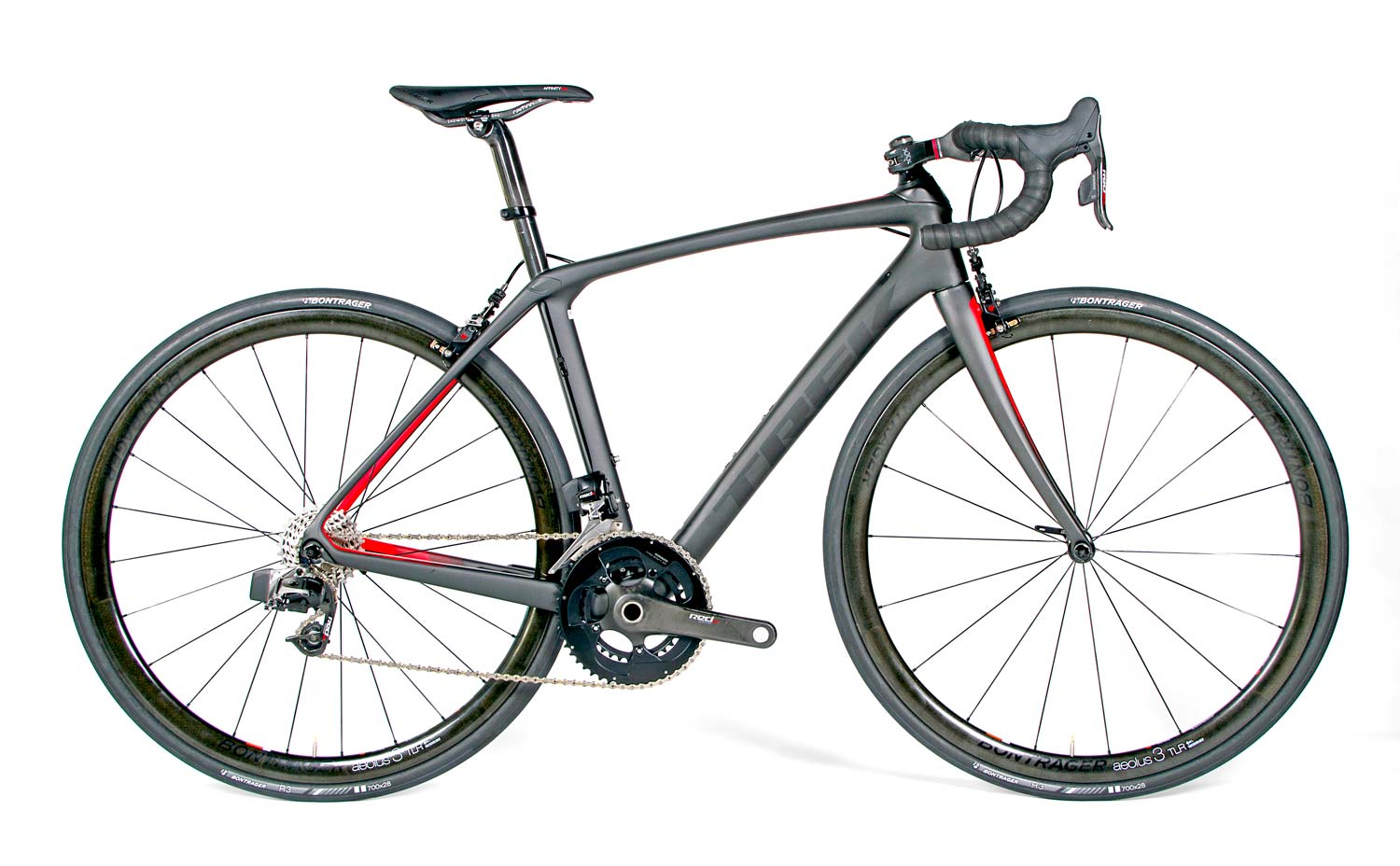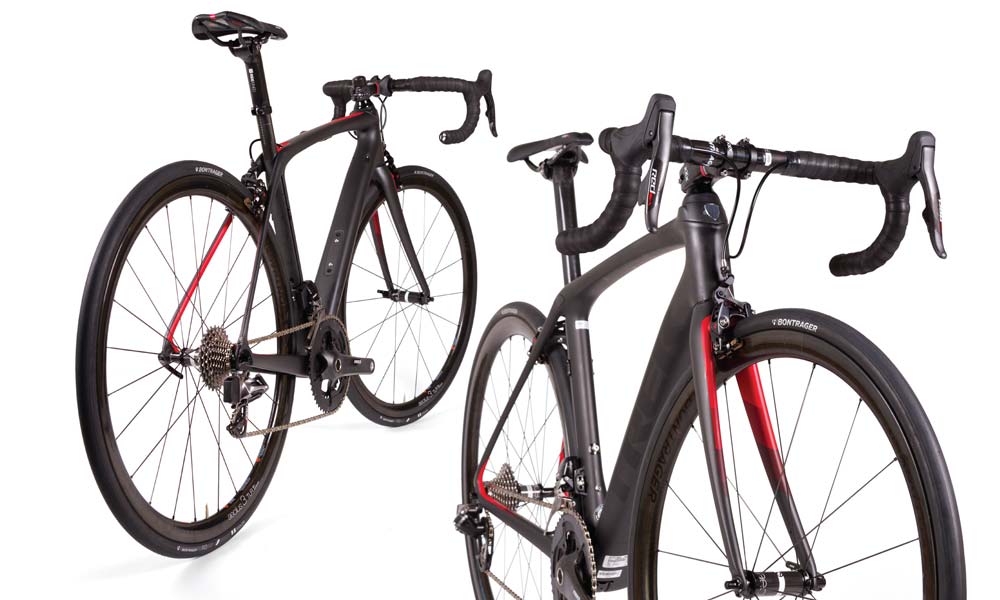[et_pb_section bb_built=”1″ admin_label=”section”][et_pb_row admin_label=”row”][et_pb_column type=”1_4″][et_pb_text admin_label=”Text” background_layout=”light” text_orientation=”left” use_border_color=”off” border_color=”#ffffff” border_style=”solid”]
Innovation for comfort and with components, the Trek Domane from 2016 was a great bike for a range of reasons. Here is our report from the workshop…
[/et_pb_text][/et_pb_column][et_pb_column type=”3_4″][et_pb_text admin_label=”Text” background_layout=”light” text_orientation=”left” use_border_color=”off” border_color=”#ffffff” border_style=”solid”]
Building Trek’s new Domane was straightforward. Despite the evolution of the frame design to include a head tube IsoSpeed decoupler as well as an adjustable one on the seat tube, time spent in the workshop was similar to that required for the previous generation.
Obviously the SLR 9 had a distinct difference to all other Trek bikes reviewed in RIDE (and any bike to this point) – the wireless eTap ensemble from SRAM.
* * * * *

Simple direct-mount brakes, an easy seatpost and bottom bracket, flawless dropouts, a straight hanger and, of course, SRAM Red eTap. This bike was the easiest five-figure bike build seen in RIDE.
The finish is perfect but designers haven’t really stretched themselves on this one. These ‘safe colours’ can be discarded by anyone who wants to buy a Trek thanks to the Project One program that has been so successful.
Yes: eTap! It’s finally here and it represents the finest cycling components money can buy.
All the in-house Bontrager stuff is the top of the line too. The Aeolus wheels are one of the most fancied products on the road and the new XXX stem is artwork.
[/et_pb_text][/et_pb_column][/et_pb_row][et_pb_row admin_label=”Row”][et_pb_column type=”4_4″][et_pb_gallery admin_label=”Gallery” gallery_ids=”33859,33860,33861″ fullwidth=”on” posts_number=”3″ orientation=”landscape” show_title_and_caption=”off” show_pagination=”off” background_layout=”light” auto=”off” hover_overlay_color=”rgba(255,255,255,0.9)” use_border_color=”off” border_color=”#ffffff” border_style=”solid” /][/et_pb_column][/et_pb_row][et_pb_row admin_label=”Row”][et_pb_column type=”1_4″][et_pb_text admin_label=”Text” background_layout=”light” text_orientation=”left” use_border_color=”off” border_color=”#ffffff” border_style=”solid”]
The IsoSpeed front decoupler is unique to Trek and provides a surprising degree of comfort out on the roads without being too complicated to build.
[/et_pb_text][/et_pb_column][et_pb_column type=”3_4″][et_pb_text admin_label=”Text” background_layout=”light” text_orientation=”left” use_border_color=”off” border_color=”#ffffff” border_style=”solid”]
Headset configuration
Logically, there must to be something different about the Domane SLR’s headset.
The bike looks and feels different to all others on the market so the assumption is that with these different characteristics comes a radical new headset design. The 2015 Madone (reviewed in RIDE #70) has an outrageously different headset configuration that needed to be carefully examined before installing it. Thankfully, the Domane’s is close to a ‘standard’ threadless headset, only with one additional part.
There is a shim that slides over the steerer tube to separate the headset’s top bearing and what Trek calls the ‘spring’ which allows the movement in the head tube.
When peering inside the head tube it becomes clear that the design is safe and thoughtful and will make a difference on the ride.
[/et_pb_text][/et_pb_column][/et_pb_row][et_pb_row admin_label=”Row”][et_pb_column type=”4_4″][et_pb_gallery admin_label=”Gallery” gallery_ids=”33862,33863,33864,33865″ fullwidth=”on” orientation=”landscape” show_title_and_caption=”on” show_pagination=”on” background_layout=”light” auto=”off” hover_overlay_color=”rgba(255,255,255,0.9)” use_border_color=”off” border_color=”#ffffff” border_style=”solid” /][/et_pb_column][/et_pb_row][et_pb_row admin_label=”Row”][et_pb_column type=”1_4″][et_pb_text admin_label=”Text” background_layout=”light” text_orientation=”left” use_border_color=”off” border_color=”#ffffff” border_style=”solid”]
Trek has its own BB configuration for the Domane and the seat mast is a rethink of traditional forms of this aspect of bicycle design.
[/et_pb_text][/et_pb_column][et_pb_column type=”3_4″][et_pb_text admin_label=”Text” background_layout=”light” text_orientation=”left” use_border_color=”off” border_color=”#ffffff” border_style=”solid”]
Bottom bracket and seat mast alterations
The bottom bracket and seat mast are two Trek staples which those familiar with the brand hope never changes.
Trek has its own bottom bracket standard, known as BB90. It is a ‘soft pressfit’ system where the bearing is pressed into each side of the 90mm bottom bracket shell.
There are recently improved covers on these bearings with a plastic clip that sits in the bearing and shields it from weather. And as this bike is SRAM eTap equipped, it requires a GXP bottom bracket that has a different non-drive side bearing to account for SRAM’s tapered spindle.
The ‘Ride Tuned’ seat mast and cap system combine the simplicity of a regular inserted post, with the low weight of an integrated seatpost.
The cap slides over the mast and is tightened to 6-7nm.
A complaint with the Ride Tuned post system was that the cap suffered small cosmetic cracks at the clamp point. This has been fixed by Trek designing two slits in the carbon (instead of one) so it can cope with the clamp force and not crack.
The Bontrager’s Affinity Pro saddle is another first for a test bike in this magazine. This saddle’s shape used to be exclusively reserved for the lower models and had a plastic shell with alloy rails.
It was comfortable yet bulky and this latest carbon update should make it a great high-end seat. It is very attractive and the 10mm carbon rails easily sat on the clamp’s carbon-specific ears.
[/et_pb_text][/et_pb_column][/et_pb_row][et_pb_row admin_label=”Row”][et_pb_column type=”4_4″][et_pb_gallery admin_label=”Gallery Domane handlebars” gallery_ids=”33868,33866,33867″ fullwidth=”on” orientation=”landscape” show_title_and_caption=”on” show_pagination=”on” background_layout=”light” auto=”off” hover_overlay_color=”rgba(255,255,255,0.9)” use_border_color=”off” border_color=”#ffffff” border_style=”solid” /][/et_pb_column][/et_pb_row][et_pb_row admin_label=”Row”][et_pb_column type=”1_4″][et_pb_text admin_label=”Text” background_layout=”light” text_orientation=”left” use_border_color=”off” border_color=”#ffffff” border_style=”solid”]
Gel inserts are another element of the comfort package but one of Trek’s great innovations is the Blendr stem which has very functional housings for additional components such as lights and cycle computers…
[/et_pb_text][/et_pb_column][et_pb_column type=”3_4″][et_pb_text admin_label=”Text” background_layout=”light” text_orientation=”left” use_border_color=”off” border_color=”#ffffff” border_style=”solid”]
Handlebars
The Domane SLR comes with Bontrager’s IsoCore handlebars. They have a reasonably shallow bend and will be very comfortable as they have provisions to fit Bontrager’s IsoZone foam onto them.
It makes the bar tape look extra thick but it is just removable foam on the bars.
It is better than the gel that some people used to wrap bar tape over because it does not squash down and bunch up (nor does it get gross and stinky from being in the sun under sweaty hands for long periods).
These bars are said to have a form of dampening built into them so between that, the foam, and the Isospeed decoupler at the front of the bike, a person’s hands will never have rested so comfortably.
[/et_pb_text][/et_pb_column][/et_pb_row][et_pb_row admin_label=”Row”][et_pb_column type=”4_4″][et_pb_gallery admin_label=”Gallery” gallery_ids=”33870,33871,33869,33872″ fullwidth=”on” orientation=”landscape” show_title_and_caption=”on” show_pagination=”on” background_layout=”light” auto=”off” hover_overlay_color=”rgba(255,255,255,0.9)” use_border_color=”off” border_color=”#ffffff” border_style=”solid” /][/et_pb_column][/et_pb_row][et_pb_row admin_label=”Row”][et_pb_column type=”1_4″][et_pb_text admin_label=”Text” background_layout=”light” text_orientation=”left” use_border_color=”off” border_color=”#ffffff” border_style=”solid”]
Bontrager has released a new iteration of the direct-mount calipers in 2017 but the 2016 version were a significant improvement on what came before…!
[/et_pb_text][/et_pb_column][et_pb_column type=”3_4″][et_pb_text admin_label=”Text” background_layout=”light” text_orientation=”left” use_border_color=”off” border_color=”#ffffff” border_style=”solid”]
Direct-mount brakes
It’s well documented that SRAM is yet to develop direct-mount brakes, instead preferring to push the hydraulic rim brake system that has not really taken off. (We have yet to see them, let alone work on them. But apparently they are “out there” and that they are pretty good… if you’re interested.)
Bontrager’s lightweight direct-mount calipers are used in lieu of SRAM branded products.
These have been fitted on the top-level Emonda bikes for a while and have received positive reviews.
It is important to fit these calipers correctly because the old Bontrager direct-mount brakes were rather rank. Made of cheap aluminium they would warp under braking and get super spongy after two or three rides.
These latest calipers are easy to adjust and very snappy on the workstand – a road test will determine their quality but the signs are good for these calipers.
[/et_pb_text][/et_pb_column][/et_pb_row][et_pb_row admin_label=”Row”][et_pb_column type=”4_4″][et_pb_gallery admin_label=”Gallery” gallery_ids=”33873,33875,33874″ fullwidth=”on” orientation=”landscape” show_title_and_caption=”on” show_pagination=”on” background_layout=”light” auto=”off” hover_overlay_color=”rgba(255,255,255,0.9)” use_border_color=”off” border_color=”#ffffff” border_style=”solid” /][/et_pb_column][/et_pb_row][et_pb_row admin_label=”Row”][et_pb_column type=”1_4″][et_pb_text admin_label=”Text” background_layout=”light” text_orientation=”left” use_border_color=”off” border_color=”#ffffff” border_style=”solid”]
SRAM eTap made its debut on the market in 2016 and it continues to set the standard in workshop simplicity…!
[/et_pb_text][/et_pb_column][et_pb_column type=”3_4″][et_pb_text admin_label=”Text” background_layout=”light” text_orientation=”left” use_border_color=”off” border_color=”#ffffff” border_style=”solid”]
SRAM Red eTap
(Note: this review was from 2016 when eTap was first available to the public.)
Finally, the wireless eTap gets a start in our build report. As expected, it has changed the way we put a bike together.
No cables means a much cleaner look from handlebars to rear derailleur and not having to route the gear cables is a novelty that will never grow old.
Adjustments are simple if the set-up process is done correctly.
The usual workshop elements remain: a straight derailleur hanger and the limit screws must be set to get a crisp rear shift – except the front derailleur can be set and relied upon before the chain is even installed.
Using the guides on the front derailleur cage, the front derailleur is positioned using the big chainrings and then SRAM’s Yaw design does the rest.
SRAM’s eTap’s simplicity is exactly as expected.
The cable-free ensemble is really easy to install and the removable batteries charge very quickly. It’s great when hype materialises and the eTap groupset is sure to have other manufacturers on their heels for a while.
[/et_pb_text][/et_pb_column][/et_pb_row][et_pb_row admin_label=”Row”][et_pb_column type=”4_4″][et_pb_image admin_label=”Image” src=”https://www.ridemedia.com.au/wp-content/uploads/2017/08/1-DSC07910.jpg” show_in_lightbox=”off” url_new_window=”off” use_overlay=”off” animation=”left” sticky=”off” align=”left” force_fullwidth=”off” always_center_on_mobile=”on” use_border_color=”off” border_color=”#ffffff” border_style=”solid” /][/et_pb_column][/et_pb_row][/et_pb_section]



